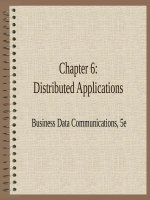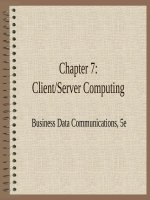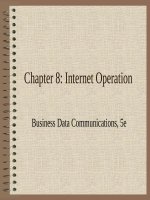Business data communications 4e chapter 3
Bạn đang xem bản rút gọn của tài liệu. Xem và tải ngay bản đầy đủ của tài liệu tại đây (246.8 KB, 15 trang )
Chapter 3 :
Distributed Data Processing
Business Data Communications, 4e
Centralized Data Processing
✘ Centralized computers, processing, data,
control, support
✘ What are the advantages?
✘ Economies of scale (equipment and personnel)
✘ Lack of duplication
✘ Ease in enforcing standards, security
Distributed Data Processing
✘ Computers are dispersed throughout
organization
✘ Allows greater flexibility in meeting
individual needs
✘ More redundancy
✘ More autonomy
Why is DDP Increasing?
✘ Dramatically reduced workstation costs
✘ Improved user interfaces and desktop power
✘ Ability to share data across multiple servers
DDP Pros & Cons
✘ There are no “one-size-fits-all” solutions
✘ Key issues
✘ How does it affect end-users?
✘ How does it affect management?
✘ How does it affect productivity?
✘ How does it affect bottom-line?
Benefits of DDP
✘ Responsiveness
✘ Availability
✘ Correspondence to Org.
Patterns
✘ Resource Sharing
✘ Incremental Growth
✘ Increased User
Involvement & Control
✘ End-user Productivity
✘ Distance & location
independence
✘ Privacy and security
✘ Vendor independence
✘ Flexibility
Drawbacks of DDP
✘ More difficulty test & failure diagnosis
✘ More components and dependence on communication
means more points of failure
✘ Incompatibility of components
✘ Incompatibility of data
✘ More complex management & control
✘ Difficulty controlling information resources
✘ Suboptimal procurement
✘ Duplication of effort
Reasons
for
DDP
✘ Need for new applications
✘ On large centralized systems, development can take
years
✘ On small distributed systems, development can be
component-based and very fast
✘ Need for short response time
✘ Centralized systems result in contention among users
and processes
✘ Distributed systems provide dedicated resources
The DP “Pendulum”
✘ Centralized systems (mainframes, etc)
✘ Distributed systems (PCs)
✘ Networked systems
✘ Client-Server computing
Client/Server Architecture
✘ Combines advantages of distributed and
centralized computing
✘ Cost-effective, achieves economies of scale
✘ Flexible, scalable approach
Intranets
✘ Uses Internet-based standards & TCP/IP
✘ Content is accessible only to internal users
✘ A specialized form of client/server
architecture
Extranets
✘ Similar to intranet, but provides access to
controlled number of outside users
✘ Vendors/suppliers
✘ Customers
Distributed applications
✘ Horizontal partitioning
✘ Different applications on different systems
✘ One application replicated on systems
✘ Example: Office automation
✘ Vertical partitioning
✘ One application dispersed among systems
✘ Example: Retail chain POS, inventory, analysis
Distributed data
✘ Centralized database
✘ Pro: No duplication of data
✘ Con: Contention for access
✘ Replicated database
✘ Pro: No contention
✘ Con: High storage and data reorg/update costs
✘ Partitioned database
✘ Pro: No duplication, limited contention
✘ Con: Ad hoc reports more difficult to assemble
Networking Implications
✘ Connectivity requirements
✘ What links between components are necessary?
✘ Availability requirements
✘ Percentage of time application or data is available to
users
✘ Performance requirements
✘ Response time requirements









